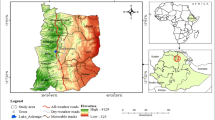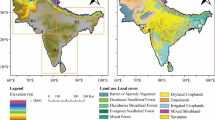Abstract
Meteorological drought has been an inevitable natural disaster throughout Mexican history and the northern and northwestern parts of Mexico (i.e., the studied area), where the mean annual precipitation (MAP) is less than 500 mm, have suffered even more from droughts in the past. The aim of this study was to conduct a meteorological drought analysis of the available MAP data (1950–2013) from 649 meteorological stations selected from the studied area and to predict the drought features under the different IPCC-prescribed climate change scenarios. To determine the long-term drought features, we collected 1×104 synthetic samples using the periodic autoregressive moving average (PARMA) model for each rainfall series. The simulations first consider the present prevailing precipitation conditions (i.e., the average from 1950 to 2013) and then the precipitation anomalies under IPCC-prescribed RCP 4.5 scenario and RCP 8.5 scenario. The results indicated that the climate changes under the prescribed scenarios would significantly increase the duration and intensity of droughts. The most severe impacts may occur in the central plateau and in the Baja California Peninsula. Thus, it will be necessary to establish adequate protective measures for the sustainable management of water resources in these regions.
Similar content being viewed by others
References
CENAPRED. 2014. Droughts. Mexico: Secretariat of the Interior-National Disaster Prevention Center, 15–20. (in Spanish)
CONAGUA. 2014. Mexico Water Atlas 2014. Mexico: Secretariat of Environment and Natural Resources-National Water Commission, 28–41, 84–95. (in Spanish)
CONAPO. 2015. Population Estimates and Projections in Mexico for 2010 to 2030. Mexico: Secretariat of the Interior-National Population Center. [2015-05-15]. http://www.conapo.gob.mx/es/CONAPO/Proyecciones_Datos.
Curl K, Neri C, Scott C A. 2015. Drought and water scarcity: discourses and competing water demands in the context of climate change in arid Sonora, Mexico. In: Stucker D, Lopez-Gunn E. Adaptation to Climate Change through Water Resources Management: Capacity, Equity and Sustainability. New York: Routledge.
de Menocal P B. 2001. Cultural responses to climate change during the late Holocene. Science, 292(5597): 667–673.
Esparza M. 2014. Drought and water shortages in Mexico. Current Status and future prospects. Secuencia, 89: 195–219.
Frich P, Alexander L V, Della-Marta P, et al. 2002. Observed coherent changes in climatic extremes during the second half of the twentieth century. Climate Research, 19(3): 193–212.
Gill R B. 2000. The Great Maya Droughts: Water, Life, and Death. Albuquerque: University of New Mexico Press, 484.
Hernandez-Cerda M E, Valdez-Madero G. 2004. Meteorological drought. In: Martínez A J, Patricia O. Climate Change: A Mexican Sight. Mexico: Secretariat of Environment and Natural Resources-National Institute of Ecology and Climate Change, 315–326. (in Spanish)
INECC. 2014. Climate Change Scenarios. Mexico: Secretariat of Environment and Natural Resources-National Institute of Ecology and Climate Change. [2014-09-20]. http://escenarios.inecc.gob.mx/.
INEGI. 2015. National Institute of Statistics and Geography, Mexico. [2015-05-10]. http://www.inegi.org.mx/.
IPCC. 2013. Summary for policymakers. In: Stocker T F, Qin D, Plattner G K, et al. Climate Change 2013: The Physical Science Basis. Working Group I Contribution to the Fifth Assessment Report of the Intergovernmental Panel on Climate Change. Cambridge: Cambridge University Press.
Kahil M T, Dinar A, Albiac J. 2015. Modeling water scarcity and droughts for policy adaptation to climate change in arid and semiarid regions. Journal of Hydrology, 522: 95–109.
Karabulut M. 2015. Drought analysis in Antakya-Kahramanmaras Graben, Turkey. Journal of Arid Land, 7(6): 741–754.
Lehner B, öll P, Alcamo J, et al. 2006. Estimating the impact of global change on flood and drought risks in Europe: a continental, integrated analysis. Climatic Change, 75(3): 273–299.
Li Y P, Ye W, Wang M, et al. 2009. Climate change and drought: a risk assessment of crop-yield impacts. Climate Research, 39(1): 31–46.
Liu F G, Feng Z D. 2012. A dramatic climatic transition at ~4000 cal. yr BP and its cultural responses in Chinese cultural domains. The Holocene, 22(10): 1181–1197.
Lloyd-Hughes B. 2014. The impracticality of a universal drought definition. Theoretical and Applied Climatology, 117(3): 607–611.
Loukas A, Vasiliades L, Tzabiras J. 2007. Evaluation of climate change on drought impulses in Thessaly, Greece. European Water, 17–18: 17–28.
Magaña-Rueda V O. 2006. Report on future scenarios for the water sector in Mexico. Mexico: Secretariat of Environment and Natural Resources-National Institute of Ecology and Climate Change, 571–673. (in Spanish)
McIntosh R J, Tainer J A. 2000. Climate, history, and human actions. In: McIntosh R J, Tainer J A, McIntosh S K. The Way the Wind Blows: Climate, History and Human Action. New York: Columbia University Press, 1–42.
Mishra A K, Singh V P. 2011. Drought modeling–a review. Journal of Hydrology, 403(1–2): 157–175.
NDMC. 2016. National Drought Mitigation Center. Types of Drought. [2016-04-26]. http://drought.unl.edu/DroughtBasics/ TypesofDrought.aspx.
Orlowsky B, Seneviratne S I. 2012. Global changes in extreme events: regional and seasonal dimension. Climatic Change, 110(3): 669–696.
Padilla G, Rodríguez L, Castorena G E, et al. 1980. Historical analysis of drought in Mexico. Mexico: Secretariat of Agriculture and Water Resources, 39–46. (in Spanish)
Parry M L, Rosenzweig C, Iglesias A, et al. 2004. Effects of climate change on global food production under SRES emissions and socio-economic scenarios. Global Environmental Change, 14(1): 53–67.
Romero-Lankao P, Smith J B, Davidson D J, et al. 2014. North America. In: Barros V R, Field C B, Dokken D J, et al. Climate Change 2014: Impacts, Adaptation, and Vulnerability. Part B: Regional Aspects. Contribution of Working Group II to the Fifth Assessment Report of the Intergovernmental Panel on Climate Change. Cambridge: Cambridge University Press, 1439–1498.
Salas J D, Delleur J W, Yevjevich V, et al. 1988. Applied Modeling of Hydrologic Time Series. Colorado: Water Resources Publications, 241–256.
SIAP. 2015. Mexico: Secretariat of Agriculture, Livestock, Rural Development, Fisheries and Food-Agrifood and Fishery Information Service. [2015-09-19]. http://www.sagarpa.gob.mx/quienesomos/datosabiertos/siap/Paginas/estadistica.aspx.
Singh M. 2006. Identifying and assessing drought hazard and risk in Africa. In: Regional Conference on Insurance and Reinsurance for Natural Catastrophe Risk in Africa, Casablanca, Morocco, November 12–14, 2006. Washington: World Bank.
Sirdas S, Sen Z K. 2003. Spatio-temporal drought analysis in the Trakya region, Turkey. Hydrological Sciences Journal, 48(5): 809–820.
Teegavarapu R S V, Chandramouli V. 2005. Improved weighting methods, deterministic and stochastic data-driven models for estimation of missing precipitation records. Journal of Hydrology, 312(1–4): 191–206.
Wang W, Ertsen M W, Svoboda M D, et al. 2016. Propagation of drought: from meteorological drought to agricultural and hydrological drought. Advances in Meteorology, 2016(1–2): 1–5.
Weiss H, Courty M A, Wetterstrom W, et al. 1993. The genesis and collapse of third millennium north mesopotamian civilization. Science, 261(5124): 995–1004.
Weiss H, Bradley R S. 2001. What drives societal collapse? Science, 291(5504): 609–610.
Yevjevich V. 1967. An objective approach to definitions and investigations of continental hydrologic drought. Hydrology Paper No. 23. Colorado: Colorado State University.
Acknowledgments
This research was supported by the Faculty of Engineering, National Autonomous University of Mexico.
Author information
Authors and Affiliations
Corresponding author
Rights and permissions
About this article
Cite this article
Escalante-Sandoval, C., Nuñez-Garcia, P. Meteorological drought features in northern and northwestern parts of Mexico under different climate change scenarios. J. Arid Land 9, 65–75 (2017). https://doi.org/10.1007/s40333-016-0022-y
Received:
Revised:
Accepted:
Published:
Issue Date:
DOI: https://doi.org/10.1007/s40333-016-0022-y




